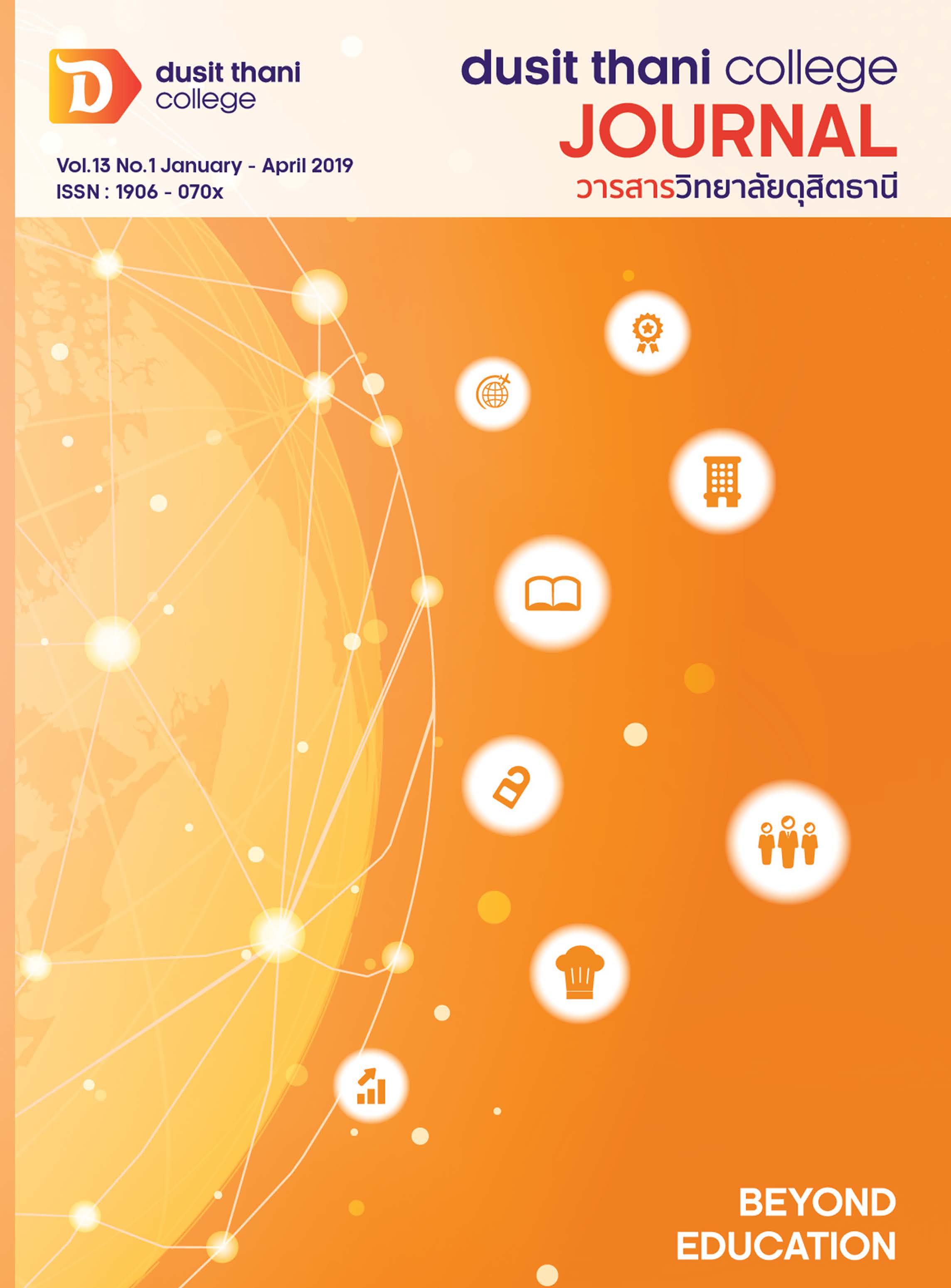Internet Use Behaviour of European Tourists Towards the Decision of Traveling to Phuket Province
Main Article Content
Abstract
This study aimed 1) to study Internet Usage behavior of European tourists towards decision of travelling to Phuket province, and 2) to compare decision making behaviors of European tourists by to personal factors. The survey sample size had been determined by testing the questionnaire with the 40 samples and calculated Partial R2 to estimate the sample size using the G*Power program according to Cohen's (1977). Based on sample estimation, the effect size is equal to 0.0683863 calculated from 40 samples. The probability of type I errors (α) is equal to 0.1 and number of variables predicted is equal to 10. Power of Test (1-ß) is equal to 0.95 (Cohen, 1962), creating sample size of 200 samples. Statistics used in data analysis are: Frequency, Percentage, Mean, and Standard Deviation (SD). Hypothesis testing was used to compare demographic differences by analyzing statistics through T-test and One - way ANOVA or F-test (analysis of variance).
The results of this study showed that most foreign tourists taking a trip to Phuket were single male, age between 26 to 35 years old with Bachelor’s degree and their monthly income is 751 - 1,500$ working as a company employee. From online media, their decision making behaviors in selecting Phuket as a travel destination, mostly came from the users’ (tourists’) ability to make decisions. Decision making in selecting Phuket as a travel destination also came from the quality of information provided by online travel media. Moreover, the online travel media information obviously helps tourists decide to travel to Phuket. The European tourists deciding to take a trip to Phuket with different genders, ages, levels of education, income and careers, however, make no difference regarding making decisions on travel.
Article Details
Article Screening Policy
- All research and academic articles to be published must be considered and screened by three peer reviews in the relevant field / article.
- All articles, texts, illustrations and tables published in the journal are the personal opinions of the authors. Editors don't always have to agree. And no responsibility whatsoever is the sole responsibility of the author.
- The articles to be published must never be published. Where did you first publish? And not in the consideration of other journals If the audit found that there has been a duplicate publication It is the sole responsibility of the author.
- Any article that the reader sees as being plagiarized or impersonated without reference. Or mislead the work of the author Please let the journal editor know it will be your greatest blessing.
References
2. Boonlert, C. (2010). Thai tourists’ Behavior in using online room reservations. Thesis paper for Degree of Master of Business Administration, Business Administration, Srinakharinwirot University. (in Thai)
3. Charuwan, J. and Kositanont, O. (2014). Behavior and Key Marketing Communication factors that Influence Purchasing Behavior from Social Media Marketing Communication. Panyapiwat Journal. 3(2), 38-49. (in Thai)
4. Chaichuy, P. and Satararuji, K. (2016). Thailand’s public issue communication through a communication innovation for campaign, website “Change.org”. Veridian E-Journal. 9(2), 1526-1536. (in Thai)
5. Chainirun, P. (2012). Types of Social Media. (online). Retrieve from: http://www.doctorpisek.com/pisek/?p=718. 11 November 2559 (in Thai)
6. Charoenkittayawut, S. (2015). A Structural Equation Model of Destination Loyalty among. European Tourists Visiting Phuket Province, Thailand. Thesis paper for Degree of Master of Business Administration, Business Administration, Prince of Songkla University. (in Thai)
7. Choolamad, K. (2014). Internet-Using Behavior and Satisfaction toward the use of internet for travelling Purpose of the tourists in Amphor Koh Phangan, Surat Thani Province. Thesis paper for Degree of Master of Communication of Art, Communication of Art, Dhurakij Pundit University. (in Thai)
8. Cohen, J. (1977). Statistical power analysis for the behavioral sciences. New York: Academic.
9. Cohen, J. (1962). The statistical power of abnormal-social psychological research: A review. Journal of Abnormal and Social Psychology, 65(3), 145-153.
10. Jariyachamsit, S. and Pasunon, P. (2559). The Decision Making for Tourism in Thailand by Foreigner Tourists. Dusit Thani College Journal. 10(1), 132-150. (in Thai)
Jittangwattana, B. (2014). Tourist Behavior. Bangkok: Fernkalaung. (in Thai)
11. Lapirattarakul, W. (1997). Public relations. Bangkok: Chulalongkorn University. (in Thai)
12. Kaewta, S. (2014). Factors relating to the decision making of Chinese Tourists on selecting the accommodation in Phuket. Thesis paper for Degree of Master of Business Administration, Business Administration, Prince of Songkla University. (in Thai)
13. Nattapongparit, A.andCheyjunya, P. (2016). Lifestyle, Perception online travel information, Credibility and Behavior of decision making for travel aboard. (online). Retrieve from: http://gscm.nida.ac.th/public-action/Proceeding/2559/16.pdf. 30 October 2559. (in Thai)
14. Nootayasakul, C. (2016). Factors of Decision Marking of Thai Tourists’ Traveling to Lampraya Market. Dusit Thani College Journal. 10(1), 132-150. (in Thai)
15. PhlaInoi, N. et al. (2015). Domestic tourist behavior of Thai tourists. Nakon Pathom. ASEAN Institute for Health Development Mahidol University. (in Thai)
16. Phuket Provincial Governor's Office. (2017). Phuket Province. (online). Retrieve from: http://www.phuket.go.th/webpk/file_data/intropk/dataPK59.pdf. 30 August 2560. (in Thai)
17. Rewtrakulpaiboon, W. (2015). Consumer behavior in tourism. Bangkok:Bangkok University. (in Thai)
18. Sophonsiri, S. (2011). Tourist behavior analysis. Bangkok: Intanin. (in Thai)
19. Suwanpimon, K. (2013). Principle of Tour Guide. Bangkok: Saengdao. (in Thai)
20. Tangpondparsert, P. (2017). The Aesthetics in Gamification Design for Supporting Rattanakosin Island Tourism. Veridian E-Journal. 10(2), 2868-2878. (in Thai)
21. Wannathanom, C. (2011). Tour planning. Bangkok: Samlada. (in Thai)
22. Warakulawit, S. (2015). tourism industry. Bangkok: Weawwaw Printing. (in Thai)
23. Wisansing, J. (2017). Who is your tourist He and she will be exactly what you offer. (online). Retrieve from:
http://www.dasta.or.th/attachments/article/1487/2-knowTourist.pdf. 30 October 2560. (in Thai)


